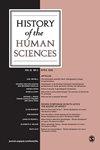行为形成:科学研究中的电影影像追踪
IF 0.5
2区 历史学
Q2 HISTORY & PHILOSOPHY OF SCIENCE
引用次数: 0
摘要
当然,利用电影进行研究有着悠久的历史,但除了记录一种现象然后将其投影出来进行演示之外,使用这项技术的科学家们还花费了大量精力来研究如何从一张胶片中提取信息。因此,理解电影(或视听)分析对于掌握研究对象、运动图像技术和科学证据之间的关系是必要的。本文探讨了电影分析历史上的一种常见技术:将电影的一个框架投射出来,然后在纸上追踪研究对象,这对发展心理学或动物行为学等行为科学尤其重要。行为通过各种方式变得有形,但对于那些依靠电影进行观察的人来说,比如发展心理学家阿诺德·格塞尔,行为至少部分是通过追踪过程形成的。格塞尔对这种技术的运用揭示了追踪的更广泛的功能,以及在创造证据的过程中与其他铭文相互作用所产生的模式。行为是如何形成的?跟踪的实践为这个更大的问题提供了一个答案。本文章由计算机程序翻译,如有差异,请以英文原文为准。
Behavior takes form: Tracing the film image in scientific research
The use of motion pictures for research has a long history, of course, but beyond documenting a phenomenon and then projecting it for demonstration, scientists using this technology spent much energy figuring out how to extract information from a strip of film. Understanding film (or audiovisual) analysis is therefore necessary to grasping the relationship between an object of study, moving-image technology, and scientific evidence. This article explores one common technique within that history of film analysis: projecting a frame of the motion picture and then tracing the object of study onto paper, which was especially important for behavioral sciences such as developmental psychology or ethology. Behavior became tangible through a variety of means, but for those who relied on film for their observations, such as developmental psychologist Arnold Gesell, behavior took form at least partly through the process of tracing. Gesell's use of this technique reveals the broader functions of tracing as well as the patterns that emerge from its interplay with other inscriptions in the creation of evidence. How does behavior take form? The practice of tracing provides one answer to this larger question.
求助全文
通过发布文献求助,成功后即可免费获取论文全文。
去求助
来源期刊

History of the Human Sciences
综合性期刊-科学史与科学哲学
CiteScore
1.60
自引率
11.10%
发文量
31
审稿时长
>12 weeks
期刊介绍:
History of the Human Sciences aims to expand our understanding of the human world through a broad interdisciplinary approach. The journal will bring you critical articles from sociology, psychology, anthropology and politics, and link their interests with those of philosophy, literary criticism, art history, linguistics, psychoanalysis, aesthetics and law.
 求助内容:
求助内容: 应助结果提醒方式:
应助结果提醒方式:


